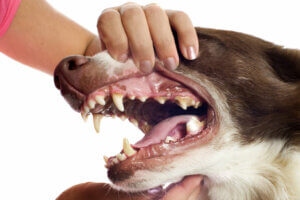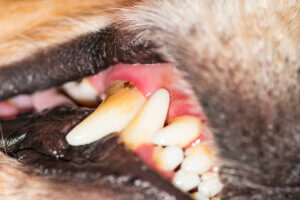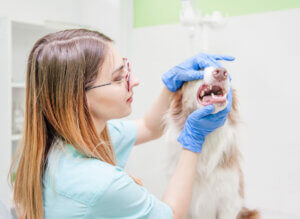Tartar in Dogs: 6 Consequences


Written and verified by the biologist Samuel Sanchez
Domestic dogs’ dental health tends to be neglected by some owners. Many believe that these animals, due to their “wild” condition, don’t require extensive dental care and cleaning. Nothing’s further from the truth, as the consequences of tartar in dogs can be serious.
As excessive as it may seem, various veterinary websites recommend brushing dogs’ teeth daily. Scientists proved that this reduces considerably the probability of bacterial diseases and gum inflammation (gingivitis), among many other illnesses.
What is tartar?
Websites specialized in dental health indicate that tartar is a dental plaque that has hardened by the precipitation of minerals in saliva and gingival fluid. Tartar is a mix of organic and inorganic matter, but the latter is predominant —up to 60%.
Tartar gives the dental plaque formed by bacteria a more extensive surface to grow on. As with humans, this can lead to a series of mild and serious diseases in dogs. Therefore, tartar isn’t only an aesthetic issue because it can compromise the health of those who have it.

What are the consequences of tartar in dogs?
The formation of tartar doesn’t only compromise the oral hygiene of the dog. In more serious cases, it can also turn into certain systemic diseases. Below, we show you the 6 consequences of tartar in dogs.
1. Bad breath: a direct consequence of tartar in dogs
Bad breath in dogs is very common, especially in senior dogs. The fact that a dog’s mouth smells is totally normal to us, because these animals are in close contact with feces, decomposing matter and other organic elements that, to us, are unpleasant to say the least.
Even so, when the breath reminds us of rotten food or the stench of a garbage dump, there’s surely something wrong with the dog’s oral health, especially if it’s young.
Many times, these strong smells come from bacterial colonies that have settled in the dog’s mouth, and provoke the rotting of its bones and oral mucous tissues.
2. Gingivitis
Gingivitis is the inflammation of the dog’s oral mucosa, tongue, or oropharynx. This causes the appearance of ulcers in the animal’s mouth, excessive salivation, and even difficulty eating.
When a dog has tartar, potentially pathogenic bacteria can accumulate in gums. These release toxins, which then damage the adjacent tissues. The animal’s immune system reacts to these lesions and sends white blood cells to the area of infection, a process that generates the typical inflammation of the gums.
3. Periodontitis
If gingivitis isn’t treated promptly, it turns into periodontitis. In this case, the inflammation of the gums is much more serious, as it’s accompanied by a degeneration of the bones and supporting structures around the dog’s teeth. This process can be controlled but not completely cured as bone damage already occurred.
It’s the most common cause of dental disease in dogs. Veterinary portals estimate that 80% of domestic dogs suffer from this disease or similar ones starting from 2 years of age. Halitosis or bad breath is the first detectable clinical sign of periodontitis. If not treated, it can lead to much worse conditions.
4. Loss of teeth
This process is completely linked to periodontitis, as pathogenic oral bacteria cause the degeneration of teeth and their support structure. Dental fractures can be complicated or not, depending on whether nerves and blood capillaries remain exposed after the lesion.
The most common symptoms following teeth loss or breakage are pain, discomfort, and bleeding near the affected structure. So, if the injury isn’t treated, it can lead to a systemic infection.
5. Endocarditis due to tartar in dogs
Endocarditis is an infection of the endocardium, the tissue that lines the inside of the heart’s valves and chambers. Strangely enough, bacteria from the dog’s mouth can grow out of control and enter the bloodstream (bacteremia), and then migrate into the heart tissue and settle in it.
This results in symptoms such as lethargy, anorexia, weight loss and weakness in the animal. Respiratory distress, increased blood pressure and intermittent fever may also appear. If not treated with antibiotics, a dog with endocarditis can die.
6. Kidney and liver failure
Bacteria that enter the bloodstream after periodontitis, can also migrate to the liver and kidneys. This results in renal and hepatic failures that lead to extensive symptomatology, depending on the place and severity of the infection.

As you can see, the consequences of tartar in dogs go far beyond bad breath. Bacterial colonies that settle due to poor oral hygiene can cause tooth loss, gingivitis, and even serious systemic diseases.
Therefore, it’s ideal to brush the dog’s teeth every day, without excuses. Finally, if you can’t do it for any reason, there are products that take care of the dog’s oral hygiene without having to brush its teeth.
Domestic dogs’ dental health tends to be neglected by some owners. Many believe that these animals, due to their “wild” condition, don’t require extensive dental care and cleaning. Nothing’s further from the truth, as the consequences of tartar in dogs can be serious.
As excessive as it may seem, various veterinary websites recommend brushing dogs’ teeth daily. Scientists proved that this reduces considerably the probability of bacterial diseases and gum inflammation (gingivitis), among many other illnesses.
What is tartar?
Websites specialized in dental health indicate that tartar is a dental plaque that has hardened by the precipitation of minerals in saliva and gingival fluid. Tartar is a mix of organic and inorganic matter, but the latter is predominant —up to 60%.
Tartar gives the dental plaque formed by bacteria a more extensive surface to grow on. As with humans, this can lead to a series of mild and serious diseases in dogs. Therefore, tartar isn’t only an aesthetic issue because it can compromise the health of those who have it.

What are the consequences of tartar in dogs?
The formation of tartar doesn’t only compromise the oral hygiene of the dog. In more serious cases, it can also turn into certain systemic diseases. Below, we show you the 6 consequences of tartar in dogs.
1. Bad breath: a direct consequence of tartar in dogs
Bad breath in dogs is very common, especially in senior dogs. The fact that a dog’s mouth smells is totally normal to us, because these animals are in close contact with feces, decomposing matter and other organic elements that, to us, are unpleasant to say the least.
Even so, when the breath reminds us of rotten food or the stench of a garbage dump, there’s surely something wrong with the dog’s oral health, especially if it’s young.
Many times, these strong smells come from bacterial colonies that have settled in the dog’s mouth, and provoke the rotting of its bones and oral mucous tissues.
2. Gingivitis
Gingivitis is the inflammation of the dog’s oral mucosa, tongue, or oropharynx. This causes the appearance of ulcers in the animal’s mouth, excessive salivation, and even difficulty eating.
When a dog has tartar, potentially pathogenic bacteria can accumulate in gums. These release toxins, which then damage the adjacent tissues. The animal’s immune system reacts to these lesions and sends white blood cells to the area of infection, a process that generates the typical inflammation of the gums.
3. Periodontitis
If gingivitis isn’t treated promptly, it turns into periodontitis. In this case, the inflammation of the gums is much more serious, as it’s accompanied by a degeneration of the bones and supporting structures around the dog’s teeth. This process can be controlled but not completely cured as bone damage already occurred.
It’s the most common cause of dental disease in dogs. Veterinary portals estimate that 80% of domestic dogs suffer from this disease or similar ones starting from 2 years of age. Halitosis or bad breath is the first detectable clinical sign of periodontitis. If not treated, it can lead to much worse conditions.
4. Loss of teeth
This process is completely linked to periodontitis, as pathogenic oral bacteria cause the degeneration of teeth and their support structure. Dental fractures can be complicated or not, depending on whether nerves and blood capillaries remain exposed after the lesion.
The most common symptoms following teeth loss or breakage are pain, discomfort, and bleeding near the affected structure. So, if the injury isn’t treated, it can lead to a systemic infection.
5. Endocarditis due to tartar in dogs
Endocarditis is an infection of the endocardium, the tissue that lines the inside of the heart’s valves and chambers. Strangely enough, bacteria from the dog’s mouth can grow out of control and enter the bloodstream (bacteremia), and then migrate into the heart tissue and settle in it.
This results in symptoms such as lethargy, anorexia, weight loss and weakness in the animal. Respiratory distress, increased blood pressure and intermittent fever may also appear. If not treated with antibiotics, a dog with endocarditis can die.
6. Kidney and liver failure
Bacteria that enter the bloodstream after periodontitis, can also migrate to the liver and kidneys. This results in renal and hepatic failures that lead to extensive symptomatology, depending on the place and severity of the infection.

As you can see, the consequences of tartar in dogs go far beyond bad breath. Bacterial colonies that settle due to poor oral hygiene can cause tooth loss, gingivitis, and even serious systemic diseases.
Therefore, it’s ideal to brush the dog’s teeth every day, without excuses. Finally, if you can’t do it for any reason, there are products that take care of the dog’s oral hygiene without having to brush its teeth.
All cited sources were thoroughly reviewed by our team to ensure their quality, reliability, currency, and validity. The bibliography of this article was considered reliable and of academic or scientific accuracy.
- ¿Qué es el sarro? Colgate. Recogido a 23 de diciembre en https://www.colgate.es/oral-health/articles/what-is-tartar#:~:text=El%20sarro%2C%20a%20veces%20denominado,puede%20irritar%20los%20tejidos%20gingivales.
- Albuquerque, C., Morinha, F., Requicha, J., Martins, T., Dias, I., Guedes-Pinto, H., … & Viegas, C. (2012). Canine periodontitis: the dog as an important model for periodontal studies. The Veterinary Journal, 191(3), 299-305.
- Sisson, D., & Thomas, W. P. (1984). Endocarditis of the aortic valve in the dog. Journal of the American Veterinary Medical Association, 184(5), 570-577.
- Lou, M. H. (2009). U.S. Patent Application No. 12/010,910.
This text is provided for informational purposes only and does not replace consultation with a professional. If in doubt, consult your specialist.








